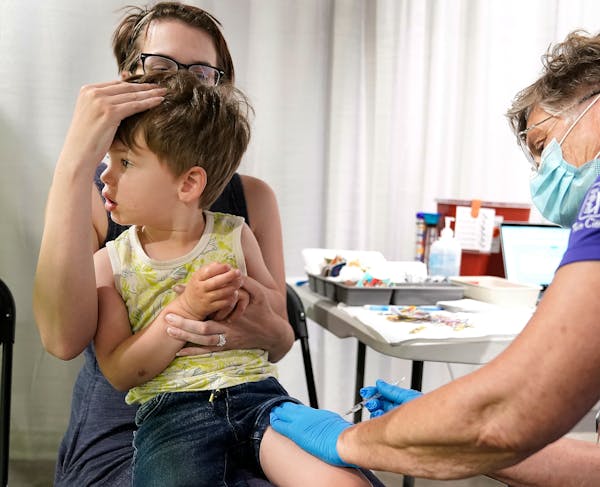Minnesota students have to catch up about a full grade level of math lost during the pandemic, and education researchers are calling on schools to mount concentrated efforts to help students who are drastically behind.
That's according to a new report from researchers at Harvard and Stanford universities that examined scores from state assessments and recently released data from national exams. They found students in most states nationwide lost ground in math and reading skills.
Several Minnesota school districts, including Minneapolis, Hopkins, Roseville, Mounds View and North St. Paul-Maplewood-Oakdale, stood out — compared with districts around the country — for their Black and Latino students' pronounced slide in math.
The research was shared exclusively with the Associated Press and member news organizations. To reach their conclusions, the researchers compared recent test scores to test scores from 2019 and calculated how many academic years of learning were lost over that time.
Researchers found that, on average, Minnesota students fell behind in math by nearly a full year. Latino students are about one year below grade level while Black students are about three-fourths of a year behind.
The state's students are also about half a year behind in reading, the study found. No state saw an increase in math.
Three other states posted slides in math similar to Minnesota's: New Mexico, Oklahoma and Maryland.
Thomas Kane, faculty director of the Center for Education Policy Research at Harvard University, likened the stall in academic improvement to a school bus stuck in gridlocked traffic. The vehicle didn't move at all during the pandemic, he said, but its destination and time of arrival also didn't change while it was at a standstill.
"Now traffic is flowing again, but it's flowing at the same speed as it was flowing before the pandemic. Somehow, we've got to accelerate that school bus to make up for the lost ground," Kane said during a media call Wednesday.
The researchers gathered data on districts' time spent in remote learning during the pandemic, but noted it was just one of many factors in students' learning.
"Clearly, remote learning was not the only factor driving achievement losses," Kane said.
Several Minnesota districts highlighted in the national research declined interviews Thursday.
North St. Paul-Maplewood-Oakdale used COVID relief funds to hire an unspecified number of math specialists to support teachers and students across grades K-12. Hopkins brought on a districtwide math specialist to help define what math and learning pathways should look like for students and to help strengthen math instruction.
In Minneapolis Public Schools, Black students in fourth through eighth grades are nearly two years behind in math compared with test results from 2019. That means a theoretical eighth-grader today must vault from turning fractions into decimals and percentages — sixth-grade math — to understanding the principles of algebra and geometry — what they're supposed to be studying now — if they're to succeed in high school.
Latino students in Minneapolis schools lost about 1.75 years in math while white students fell back by about one year.
Nearly 31% of the district's 30,000 students are Black, according to state enrollment figures; 17% are Latino.
Kenneth Eban, executive director of the Advancing Equity Coalition, says those academic slides are part of a longstanding pattern in the state's third-largest school district. He's long advocated for the district's equity initiatives and believes Minneapolis schools weren't prepared for the effects the pandemic had on students.
Students' lives were upended as world-shaking events unfolded around them, from the pandemic to a national racial reckoning and a particularly divisive presidential contest. Eban said returning to the status quo when classrooms reopened for in-person instruction was insufficient in getting kids on track.
"We need to take a moment to step back and really assess what has happened since students have been in the building full-time," Eban said.
District leaders say they're tackling the problem with an array of methods.
"Are we shocked by the fact there is such a large discrepancy? No. Is it something we are allocating monetary resources and our staff attention toward getting at? Absolutely," said Sarah Hunter, Minneapolis Public Schools' director of strategic initiatives.
The district is piloting a support team program in one South Side middle school and partnering with community groups to help students navigate the effects of the pandemic.
Additionally, Hunter said the district is providing "high-dosage" tutoring for struggling learners, has invested in a new math curriculum and has peppered professional development days for educators throughout the year instead of focusing on training in the two weeks before school begins.
Rather than offering students optional after-school tutoring, Hunter said, school leaders are identifying specific students for one-on-one attention. That extra help comes after school or during a dedicated tutoring period.
"It's a supplement — it's not supplanting core learning," Hunter said.
Teachers have also been meeting weekly in small groups to go over students' work and identify who needs further support. Hunter called the practice "one of our strongest strategies to increase the quality of core instruction."
Kane, the Harvard researcher, urges districts to make good use of the federal relief money. Minneapolis Public Schools received approximately $261 million in four installments, the last of which must be spent by the end of August 2024.
"We have this school year and next school year," Kane said. "That underscores why it's so important that districts reconsider and rescale their plans in light of the evidence of their losses."
Staff writer Anthony Lonetree and the Associated Press contributed to this report.

Souhan: This is KAT's chance to prove Flip Saunders was right

